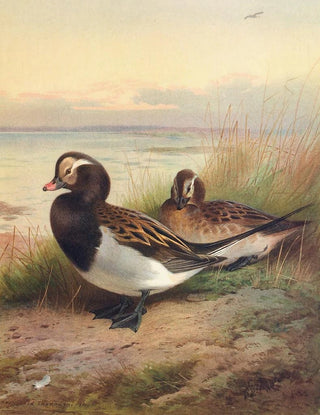Summer Lacquered Duck - Archibald Thorburn Art print


View from behind

Frame (optional)
Summer Lacquered Duck - Archibald Thorburn – Captivating Introduction
In the fascinating world of wildlife art, "Summer Lacquered Duck" by Archibald Thorburn stands out as an iconic piece that captures the very essence of nature. This painting, imbued with poetry and delicacy, transports us to the heart of aquatic landscapes where wildlife thrives. The depiction of a lacquered duck, with its vibrant colors and iridescent plumage, evokes not only the beauty of the bird but also the magic of the seasons. By contemplating this artwork, the viewer is invited to immerse themselves in a world where nature and art meet, creating a visual harmony that delights and captivates.
Style and uniqueness of the work
Archibald Thorburn's style is characterized by meticulous attention to detail and a palette of vibrant colors that breathe life into his subjects. In "Summer Lacquered Duck," each feather is rendered with remarkable precision, demonstrating the artist's careful observation. The reflections of light on the bird's plumage, as well as the shades of blue and green, create an almost magical atmosphere. Thorburn does not merely depict a duck; he manages to convey the soul of this animal, its elegance, and grace. The background, subtly blurred, highlights the main subject while suggesting a rich and lively natural environment. This work is a celebration of biodiversity, a tribute to the fragile beauty of the wildlife around us.
The artist and his influence
Archibald Thorburn, born in 1860, is considered one of the greatest wildlife artists of his time. His passion for nature and his commitment to species preservation have profoundly marked his work. Influenced by Scottish landscapes and the richness of British fauna, Thorburn was able to combine his artistic talent with a desire to raise awareness about animal protection. His illustrations have not only adorned books and magazines but also contributed to a better understanding of ecology and the necessity of preserving natural habitats. The impact of his work is still felt today, inspiring a new generation of artists and naturalists to explore

Matte finish

View from behind

Frame (optional)
Summer Lacquered Duck - Archibald Thorburn – Captivating Introduction
In the fascinating world of wildlife art, "Summer Lacquered Duck" by Archibald Thorburn stands out as an iconic piece that captures the very essence of nature. This painting, imbued with poetry and delicacy, transports us to the heart of aquatic landscapes where wildlife thrives. The depiction of a lacquered duck, with its vibrant colors and iridescent plumage, evokes not only the beauty of the bird but also the magic of the seasons. By contemplating this artwork, the viewer is invited to immerse themselves in a world where nature and art meet, creating a visual harmony that delights and captivates.
Style and uniqueness of the work
Archibald Thorburn's style is characterized by meticulous attention to detail and a palette of vibrant colors that breathe life into his subjects. In "Summer Lacquered Duck," each feather is rendered with remarkable precision, demonstrating the artist's careful observation. The reflections of light on the bird's plumage, as well as the shades of blue and green, create an almost magical atmosphere. Thorburn does not merely depict a duck; he manages to convey the soul of this animal, its elegance, and grace. The background, subtly blurred, highlights the main subject while suggesting a rich and lively natural environment. This work is a celebration of biodiversity, a tribute to the fragile beauty of the wildlife around us.
The artist and his influence
Archibald Thorburn, born in 1860, is considered one of the greatest wildlife artists of his time. His passion for nature and his commitment to species preservation have profoundly marked his work. Influenced by Scottish landscapes and the richness of British fauna, Thorburn was able to combine his artistic talent with a desire to raise awareness about animal protection. His illustrations have not only adorned books and magazines but also contributed to a better understanding of ecology and the necessity of preserving natural habitats. The impact of his work is still felt today, inspiring a new generation of artists and naturalists to explore






